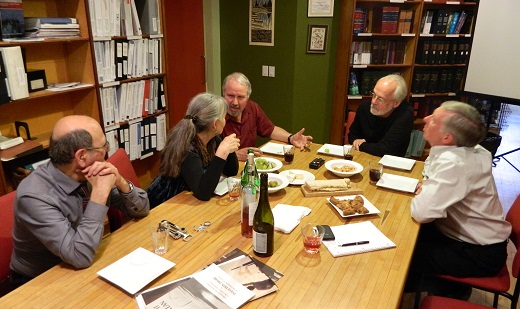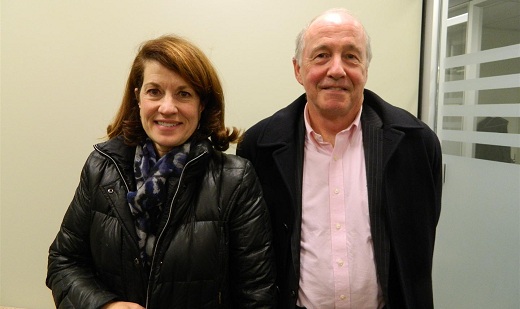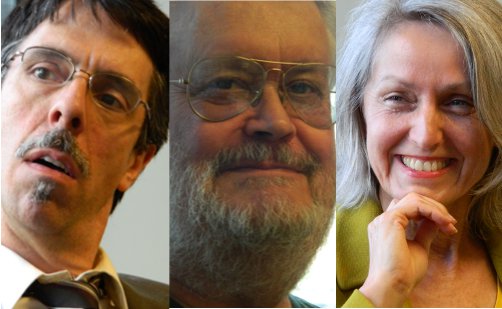
Caption: John Swaigen and Anne Wordsworth (left) talk to Pollution Probe co-founders Monte Hummel, Peter Middleton and Brian Kelly (right) talk history of Pollution Probe at the Canadian Environmental Law Association (CELA) office
On a cold February evening in 1969, several hundred students and professors gathered on the campus of the University of Toronto to watch and discuss The Air of Death, an exposé of industrial pollution that had aired on CBC television. The mood was grim. Ontario had just completed a controversial, one-sided inquiry that challenged many of the documentary’s findings. So when one of the companies portrayed in the program complained to the Canadian Radio-television and Telecommunications Commission (CRTC) that the story was biased and inaccurate, a few of those students approached zoology professor Dr. Donald Chant and asked for his help in preparing a formal brief to present to the Commission. Dr. Chant agreed, the group appeared before the CRTC, the producers of the film were exonerated and, on March 1, 1969, Pollution Probe was born.
In its first years, Pollution Probe was an exuberant, attention-grabbing, loosely-structured collective of young environmental activists. Predating both Ontario’s Ministry of the Environment , the federal Department of the Environment and most of the country’s environmental laws and regulations, Probe’s primary mission was to raise public awareness and push for change.
When concern grew over massive algal blooms in a “dying” Lake Erie, a couple of Probe staffers spent Christmas holidays testing phosphate levels in a variety of detergents and cleaning products. After the results aired on a prominent public affairs show, more than 7,000 letters poured into Probe’s makeshift offices asking for copies of their research. “We hit the sweet spot,” says Probe co-founder Brian Kelly, “Because pollution was a concern, people wanted to do something. They wanted information. We filled that void.”
In addition to pollution problems, Probe teams tackled a series of complex energy, urban development and garbage issues. Admittedly some campaigns were more guerilla theatre than science. Probers dumped bags of roadside litter on the steps of the Ontario Legislature and later hosted a “garbage picnic” with Bob the Rat. They mailed back waste packaging to manufacturers as part of the “Boomerang” campaign, while the “Pop Posse” reported retail stores that didn’t stock returnable pop. They even covertly shipped a succession of dead animals to the U.S. consulate in the days leading up to the underground testing of nuclear devices on Amchitka in Alaska’s Aleutian Islands. While violence and vandalism had no place in their tactics, the early Probers firmly believed that “humour never hurts.”
Neither did public education. Probe’s DO IT! campaign equipped Ontario teachers with the first environmental education kits to teach students about air and water pollution, noise, litter and pesticides. Travelling caravans criss-crossed the province each summer, teaching residents how to organize grassroots projects and spreading the word on recycling, household toxics and acid rain. The media were bombarded with press releases, politicians inundated with briefs and policy papers, and the public supplied with a constant stream of topical fact sheets, brochures and booklets.
By the end of the 70s, Probe’s lobbying was becoming a little more sophisticated. “Today’s grade eight student knows as much about pollution as Probe did in 1969,” said Dr. Chant on the 10th anniversary of Pollution Probe. The days of theatrical stunts and demonstrations were fading. The public, media and decision makers expected solid research underpinned by scientific data and technical expertise.
Probe researchers were also looking beyond the old-time contamination problems – belching smokestacks and dead fish floating down murky rivers – into the root causes of environmental degradation. They were now wrestling with the hidden impacts of toxic chemicals, the economic benefits of a green economy, and the imperatives of a conserver society.
In 1980, the organization moved from its long-time home on the U of T campus into Ecology House, a Victorian home retrofitted with the latest solar heating and energy saving techniques, a greywater system and a greenhouse. More than 10,000 visitors looking for green living ideas trooped through the doors of the urban conservation showplace in just the first year. In 1981, Profit from Pollution Prevention detailed hundreds of success stories – companies that were using production technologies in innovative ways to reduce, reuse or recycle wastes. In 1984, Probe helped negotiate the cleanup of toxic chemical dumpsites in New York State and, in 1986, pushed for the closure of the last garbage incinerators in southern Ontario. In 1989, the Green Consumer Guide, a compendium of alternative products and environmentally friendly household tips, became a Canadian bestseller and was quickly followed by the Canadian Junior Green Guide and the Green Kitchen Handbook.
In the more than 40 years since the birth of Pollution Probe, literally thousands of researchers, volunteers, canvassers and supporters have passed through its offices. Some licked stamps or answered phones for an afternoon, some worked through the summer as interns or on special projects, and some worked on Probe campaigns for years. Many of those former Probers have toiled in the environmental business ever since, in government, in industry, in academia and in the non-profit sector. Today, Pollution Probe continues to work quietly behind the scenes on green transportation, water management and climate change issues.

